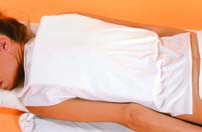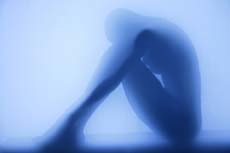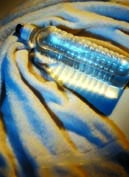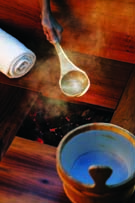Calming hydrotherapy
Since ancient times water has been used as a natural medicine to cure the human body. Hydrotherapy is the use of water at different temperatures to revitalize, maintain, and restore health.

+ There are a number of hydrotherapy techniques that can be used based on the physical needs of an individual. The most common techniques are those using hot water or vapors for their sedative effects. However, there are techniques using cold water to help fight insomnia.
SPONGE BATH
This is a simple technique that has gained importance for its beneficial effects. The entire body is wet with a washcloth or sponge as fast as possible. Begin with the forehead of the body and then continue from the neck to the base of the feet, rubbing with a sponge soaked in cold water. This therapy helps to calm the nerves and to stimulate the digestive system, favoring better absorption of nutrients and helping to bring on sleep.
COLD WRAPS
A moistened linen cloth is used on different parts of the body, and then covered with a dry woolen cloth to cover up the area. It is used on one part of the body at a time. The most common areas are the chest and abdomen. Chest compresses can be used from the head all the way to the lower back to freshen and decongest the central nerves, bringing a calming and sedative effect. Abdominal compresses are used by covering the lower part of the chest, including the ribs and pelvic bone, which helps to freshen and decongest the digestive system. It also acts as an effective therapy for the stomach, the kidneys and the bladder, getting the body ready for sleep.


OTHER HYDROTHERAPY TECHNIQUES
- • Watsu. It combines water and shiatsu, a form of Japanese finger pressure massage applied to the meridians of chi. The technique consists of floating in water and supported by the watsu practitioner, the watsu receiver passes into a state of complete relaxation as gentle stretching is applied to specific areas. More than just a massage, this technique involves a series of free-owing movements that increase exibility and strengthen muscles.
- • Scottish shower. This is a type of massage using shower jets to apply pressure. It helps to tone the muscles, it stimulates oxygen flow to the muscle tissues, increases the skin's resistance, stimulates circulation and more than anything helps to rejuvenate your body.

STEAM BATHS

Steam baths are a purifying and tranquilizing therapy. They stimulate the skin and cause sweating which cleans the body from the inside out, making you feel good and relaxed. Steam baths are a good way to fight stress and reduce nervous tension, they can help bring on sleep without any difficulties. Steam baths originated in the ancient Roman Empire and the Arab world: both cultures used thermal baths as a place for relaxation and social meetings. Today, steam baths are used as a treatment to relieve the pressures we find in our everyday lives and to improve our overall physical and mental health. There are different types:
∎ Turkish steam bath, the name comes from its place of origin, Turkey. This type of therapy consists of a series of warm, humid chambers of varying temperatures ranging between 113 °F/45 °C to 158 °F/70 °C. The heat is generated by scorching water that circulates through piping and radiators located on the walls. The humidity is such that the sweat created from the heat doesn't evaporate. Because of this, the body doesn't get cold and sweats even more.
SAFETY
Steam baths should not be taken by persons with acute infection, high blood pressure, hepatic or renal insufficiency, hyperthyroidism, inflammation of blood vessels (varicose veins, phlebotrombosis) or artherosclerosis. Before taking them, you should consult your doctor.
∎ Sauna uses dry heat; the temperature inside a sauna is generally 140 °F/60 °C, but can be higher than 203 °F/95 °C, depending on your resistance to heat. When you take a sauna you lie down on wood benches, the higher you are the hotter the air. The bath, which shouldn't last for more than 8 minutes, is done in consecutive sessions, separated by 10-minute resting intervals. Because the heat is dryer than a Turkish steam bath, the sweat on the skin dries causing a more pleasant sensation.
∎ Finnish bath consists of sitting in clouds of vapor that are produced by pouring water with essential oils of mint or eucalyptus on porous hot rocks. This steam bath, is a closed room in which temperatures can go up to 113 °F/45 °C.
It helps to purify the respiratory system and relieves tension. It is good for those who are suffering from fatigue and stress. Before taking a Finnish bath it is suggested that you consult your doctor.

IN YOUR ROOM
Hot vapor from a vaporizer with a few drops of essential oil adds to the room's humidity and helps to prevent and relieve congestion, at the same time helping to bring on sleep.

Comment about this article, ask questions, or add new information about this topic: